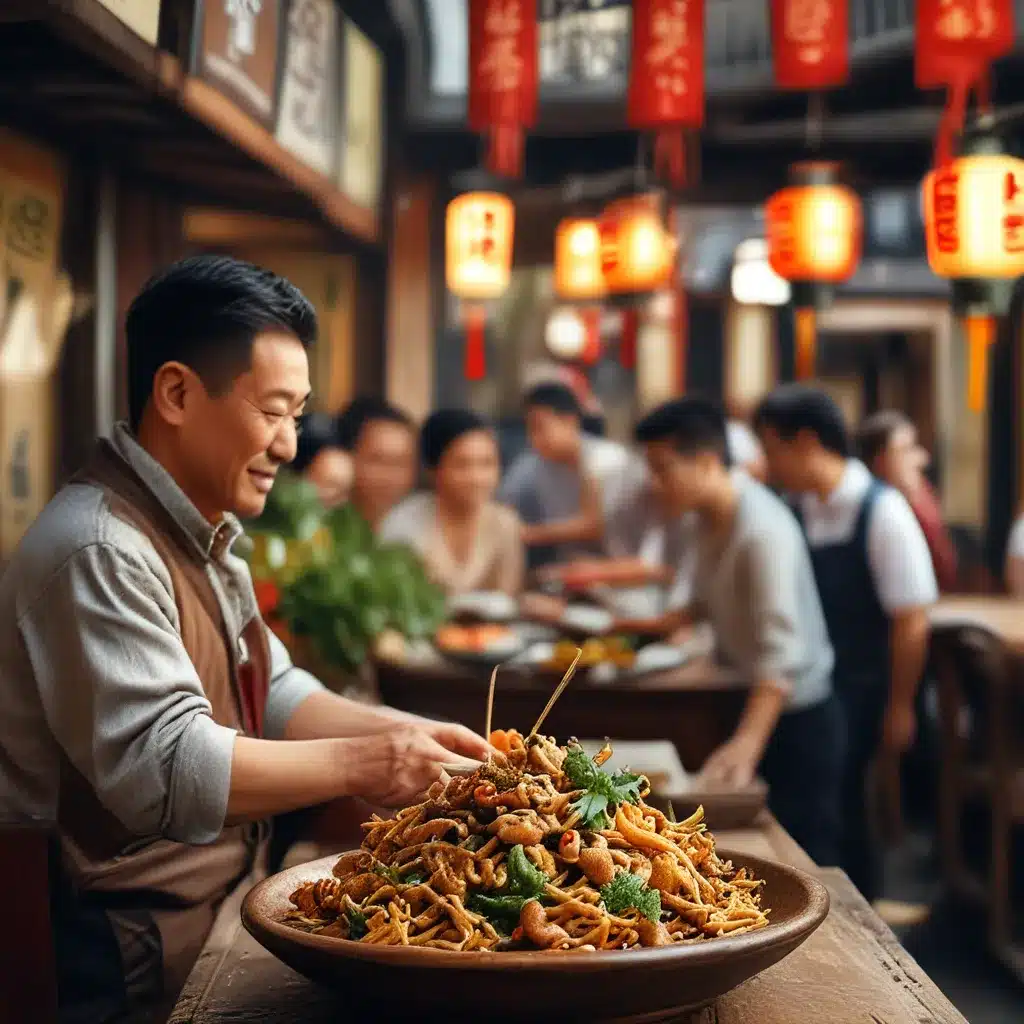
Uncovering the Culinary Gems of Shanghai’s Past
As I strolled down the bustling streets of modern-day Shanghai, it was hard to imagine the city’s rich history that lay beneath the towering skyscrapers and neon lights. But with each step, I found myself transported back in time, uncovering the flavors and stories that defined the essence of old Shanghai.
My journey began on the famous Nanjing Road, where the shadows of the past mingled with the glitz of the present. I stumbled upon One Dragon Restaurant, a hidden gem that promised to take me on a culinary adventure through the city’s bygone eras.
Unlocking the Secrets of Shanghai’s Dried Grocery Stores
Stepping into the unassuming San Yang Food Shop, I was immediately overwhelmed by the sheer variety of dried goods lining the shelves. Dried starfish, bracketed fungi, and sea cucumbers – the Chinese truly have a knack for transforming the most peculiar ingredients into culinary delights. As I navigated the maze of dried meats, fruits, and vegetables, I couldn’t help but wonder about the stories behind each item.
The pungent aroma of cured pork floss piqued my curiosity, and I couldn’t resist sampling the delicate, flaky pineapple crisps sold by the friendly ladies behind the counter. It was a tantalizing introduction to the rich tapestry of Shanghainese flavors, and I knew I was just scratching the surface.
Sipping Tea and Savoring History
As I continued my stroll, I stumbled upon the Cai Tong De pharmacy, a historic establishment dating back to 1882. The four-story building exuded an air of timelessness, its shelves brimming with traditional Chinese medicinal herbs and tonics. I couldn’t help but chuckle at the thought of the first person who decided to rub a bit of sheep placenta or deer penis on their skin, all in the pursuit of better health.
But it was the Huxingting Teahouse that truly captured my imagination. Perched on stilts above a serene lake, the pagoda-style structure was a testament to the enduring allure of the age-old Chinese tea ceremony. As I sipped my fragrant, blooming tea, I couldn’t help but wonder about the countless conversations and stories that had unfolded within these walls over the centuries.
Navigating the Labyrinth of Yuyuan Bazaar
From the charming teahouse, I ventured deeper into the Yuyuan Bazaar, a vibrant maze of shops and eateries. The air was thick with the enticing aromas of sizzling street food, and the lively chatter of vendors filled the air. I watched in awe as artisans skillfully crafted delicate jade carvings and intricate bamboo figurines, each piece a testament to the region’s rich artistic heritage.
As I wandered through the bustling alleyways, I stumbled upon the Nan Xiang Steamed Bun restaurant, where a queue of locals and tourists alike eagerly awaited their chance to savor the quintessential Shanghainese delicacy. The soft, pillowy buns, filled with savory pork, were a revelation, and I found myself quickly understanding the appeal of these humble, yet irresistible snacks.
Embracing the Flavors of Old Shanghai
But it was my visit to the Hefeng Mansion Old Town Snack Palace that truly cemented my appreciation for the culinary diversity of old Shanghai. This colossal buffet-style restaurant offered a veritable feast of regional specialties, from the fragrant Szechuan dishes to the delicate Shanghainese flavors. I savored every bite, my taste buds dancing with each new flavor profile.
As I made my way back towards the Bund, I couldn’t help but feel a deep sense of gratitude for the opportunity to immerse myself in the rich cultural tapestry of this remarkable city. The flavors I had encountered, the stories I had uncovered, and the traditions I had witnessed had all contributed to a deeper understanding of Shanghai’s past and its enduring influence on the present.
Connecting the Past to the Present
In a city that is constantly evolving, it was heartening to see the efforts made to preserve the architectural and cultural heritage of old Shanghai. The Bund, with its stunning collection of colonial-era buildings, stood as a testament to the city’s unique blend of East and West. And as I gazed across the river at the towering skyscrapers of Pudong, I couldn’t help but marvel at the seamless integration of the old and the new.
As one traveler noted, “It is this contrast of past and future that makes Shanghai such an interesting and diverse city.” And it was this very contrast that had captivated me, drawing me deeper into the rich tapestry of this extraordinary place.
Preserving the Essence of Old Shanghai
As I reflected on my journey, I couldn’t help but feel a deep admiration for the resilience and adaptability of the Shanghainese people. In a city that has weathered so many transformations, they have managed to preserve the essence of their culinary and cultural heritage, even as they embrace the rapid modernization that surrounds them.
One traveler noted, “Even though the old Shikumen houses have been turned into fancy restaurants and shops, there are still plenty of mom-and-pop shops, eateries, and vibrant local street life to be found.” This delicate balance between progress and preservation is what makes Shanghai such a fascinating and alluring destination.
As I bid farewell to the city, I knew that I would carry the flavors and stories of old Shanghai with me, a cherished memento of a journey that had awakened my senses and enriched my understanding of this dynamic and ever-evolving metropolis. And who knows, perhaps one day I’ll return, ready to uncover even more of the culinary gems that lie hidden within its streets.






